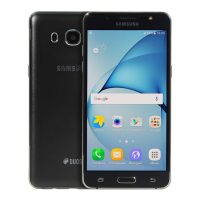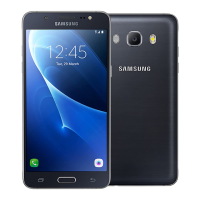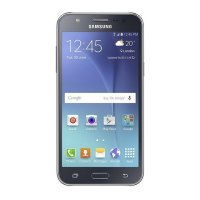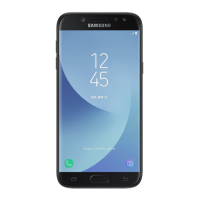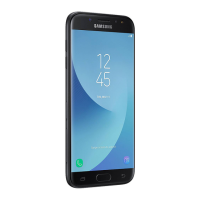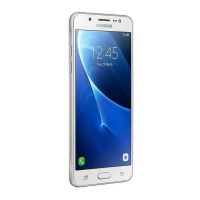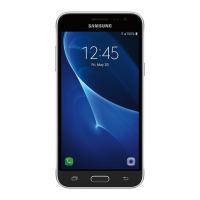Do you have a question about the Samsung SM-J510FN and is the answer not in the manual?
Explains icons for warnings, notes, and key representations.
Details intellectual property rights for the device and its components.
General safety advice, warnings, and precautions for phone use.
Key guidelines for phone operation, battery, and SIM card handling.
Details unpacking, phone's physical layout, keys, and display.
Explains icons used in the manual for various functions.
Step-by-step guide for installing SIM and battery.
Instructions on how to charge the phone's battery.
Basic operations for powering the device and navigating menus.
Options for personalizing phone settings like ringtone and profiles.
Making, answering calls, and adjusting volume.
Instructions for sending/viewing messages and managing contacts.
Solutions for common phone problems and error messages.
Precautions for hearing, mobile equipment installation, and batteries.
Avoiding pacemaker interference and using phone in explosive environments.
Reducing repetitive motion injuries and general cautionary advice.
Emphasizes prioritizing driving and using phone safely.
Following regulations and using approved accessories.
Interference with medical equipment, aircraft usage, battery protection.
Sensible handling, avoiding liquids, dust, impacts, and other devices.
Advice on holding the phone for optimal antenna performance.
Importance of qualified servicing and maximizing battery lifespan.
Precautions for handling SIM and memory cards.
Planning for emergency calls in remote areas.
Details on RF energy exposure and SAR compliance.
Specific Absorption Rate (SAR) compliance information.
Guidelines for safe mobile phone use while driving.
How to make emergency calls.
Following special regulations and switching off phone when required.
Potential interference with pacemakers and hearing aids.
Interaction with other medical devices and vehicle systems.
Adhering to notices in facilities and precautions for explosive areas.
Procedures and limitations for making emergency calls.
Warning against children playing with the phone due to risks.
Statement on FCC compliance and warnings against modifications.
Phone servicing, vehicle airbag safety, and aircraft usage.
Factors affecting call quality and signal strength indicators.
Explanation of the automatic power saving feature.
Guidelines for operating the phone properly for optimal service.
Factors influencing battery life and talk time.
Safe usage, charging, temperature effects, and battery disposal.
Suggestions for operating the phone and fulfilling warranty.
Lists items included in the phone package.
European Union directives on battery disposal and recycling.
Installing SIM/battery and charging the device.
Explains low battery warning and automatic power-off.
Learn basic operations and main features of your phone.
Procedures for powering the device and using offline profiles.
Steps to access and navigate phone menus.
Adjusting key tones, silent mode, and ringtones.
Creating profiles and selecting wallpapers.
Choosing themes and setting menu shortcuts.
Setting up and using simplified menu items.
Steps to enable and set a phone lock password.
Making, answering calls, volume, speakerphone, and headset use.
Steps for composing and sending SMS, MMS, and emails.
How to change text input modes (T9, ABC, Number, Symbol).
How to access and view received messages in Inbox.
Steps to check and retrieve emails.
How to add new entries and search the phonebook.
Explanation of Bluetooth technology and its capabilities.
Turning Bluetooth on/off and setting device visibility.
Changing device name and file browsing limits.
Steps to search for and pair with Bluetooth-enabled devices.
Options for browsing files, services, renaming, and deleting.
Sending and receiving files using Bluetooth.
Using the phone with a connected Bluetooth hands-free kit.
Overview of Wi-Fi and steps to activate the WLAN feature.
How to find and connect to a wireless local area network.
Modifying network settings like name, security, and IP address.
Connecting to a WLAN using Wi-Fi Protected Setup (WPS).
Setting the device as a wireless access point.
Connecting devices directly via Wi-Fi without a network.
Settings for enabling, searching, and connecting Wi-Fi Direct devices.
Using a PC data cable for synchronization and data transfer.
Selecting USB modes for phone communication.
Solutions for common messages like 'Insert SIM card' or 'Phone lock'.
Addressing network errors and call dialing problems.
Troubleshooting when callers cannot reach you or audio is poor.
Solutions for low battery warnings and poor call audio quality.
Troubleshooting call dialing from contacts and battery charging issues.
Explanation of normal phone heating during heavy use.
| Release Date | April 2016 |
|---|---|
| Dimensions | 145.8 x 72.3 x 8.1 mm (5.74 x 2.85 x 0.32 in) |
| Processor | Quad-core 1.2 GHz Cortex-A53 |
| Chipset | Qualcomm MSM8916 Snapdragon 410 (28 nm) |
| GPU | Adreno 306 |
| RAM | 2 GB |
| Internal Storage | 16 GB |
| Main Camera | 13 MP, f/1.9, 28mm (wide), AF |
| Operating System | Android 5.1.1 (Lollipop), upgradable to 7.1.1 (Nougat) |
| SIM | Single SIM (Micro-SIM) or Dual SIM (Micro-SIM, dual stand-by) |
| Network | GSM / HSPA / LTE |
| Bluetooth | 4.1, A2DP |
| Wi-Fi | Wi-Fi 802.11 b/g/n, Wi-Fi Direct, hotspot |
| GPS | Yes, with A-GPS, GLONASS |
| NFC | Yes (market dependent) |
| USB | microUSB 2.0 |
| Model | SM-J510FN |
| Weight | 159 g |
| Resolution | 720 x 1280 pixels |
| Expandable Storage | microSD, up to 256 GB (dedicated slot) |
| Front Camera | 5 MP, f/1.9 |
| Battery | Li-Ion 3100 mAh, removable |
| Sensors | Accelerometer, proximity |
| Colors | White, Black, Gold |

